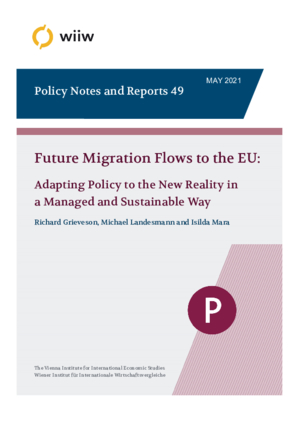Future Migration Flows to the EU: Adapting Policy to the New Reality in a Managed and Sustainable Way
Richard Grieveson, Michael Landesmann and Isilda Mara
wiiw Policy Note/Policy Report No. 49, Mai 2021
24 pages including 6 Figures
Even in a baseline scenario in terms of climate change and conflict in the EU’s neighbouring regions, there is likely to be a substantial increase in the number of people trying to reach the EU in the coming decades. Moreover, an ever larger share of those seeking to reach Europe are likely to come from Africa and the Middle East. Migration and integration policy will have to recognise this fact. In this policy note, we do three things. First, we assess the push and pull factors for migration to the EU, provide an overview of the debates about migration in the EU currently, and how these create the structures within which politicians can act. Second, we give an overview of EU policy on migration as it stands, and in particular its evolution since the migration and refugee crisis of 2015-2016. Finally, we detail our proposals for how EU migration policy should evolve in order to meet the challenges that the coming decades will bring. We conclude that the EU must manage future migration flows via a partnership approach, particularly in relation to Africa. The EU should also encourage circular migration, be flexible, devote sufficient resources to support refugees in its neighbouring regions, tackle integration challenges, and communicate properly and honestly.
Keywords: Africa, Middle East, Eastern EU partnership countries, migration, migration policy, demographic developments, refugees, migration policies
JEL classification: F22, J11, J61, O15
Countries covered: Africa, CEE, EU neighbouring countries, European Union, Middle East, New EU Member States, Wider Europe
Research Areas: Labour, Migration and Income Distribution
